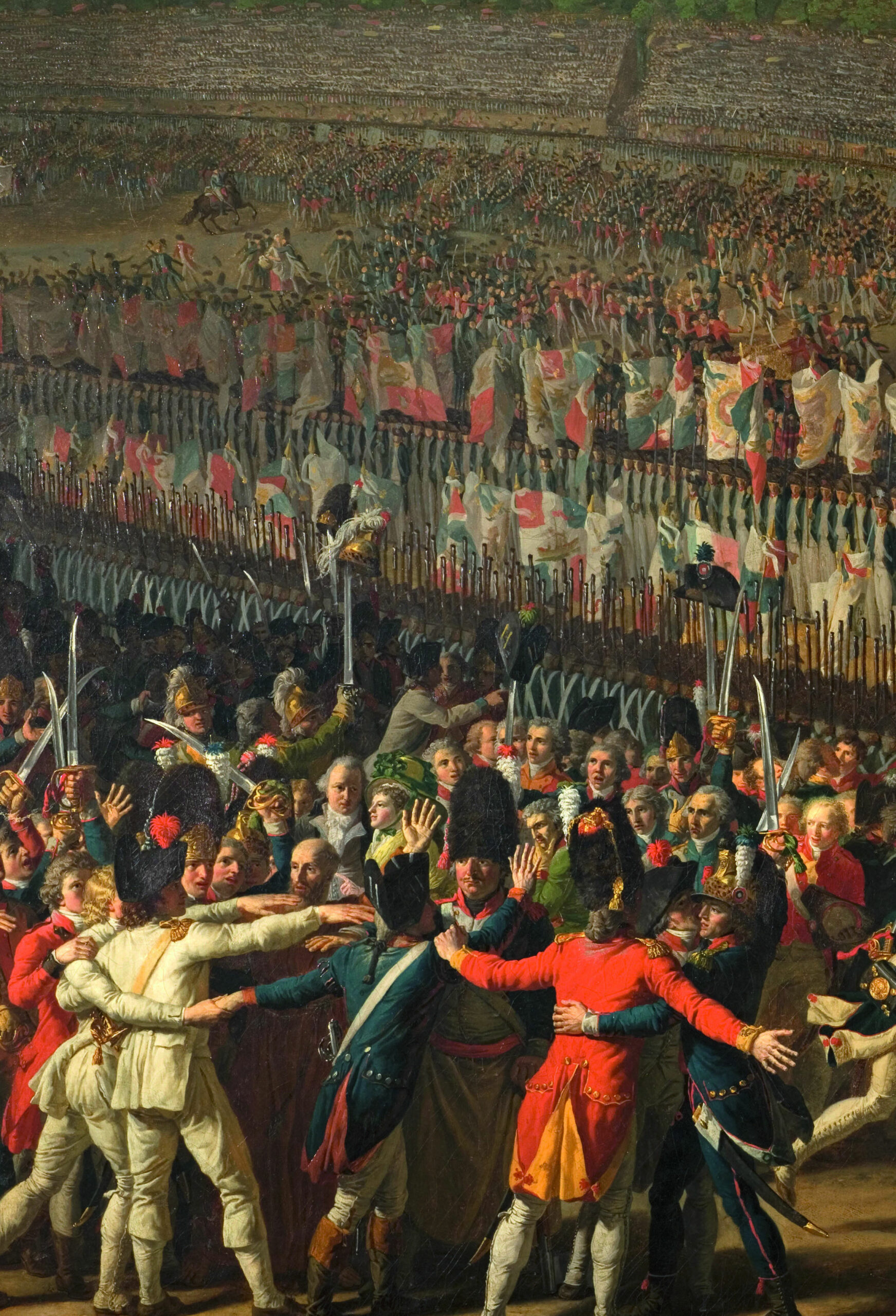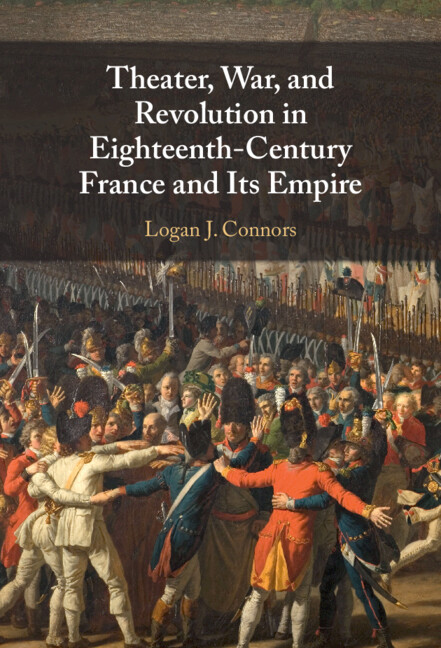
These are some of the questions that I seek to answer in my new book, Theater, War, and Revolution in Eighteenth-Century France and Its Empire. My study traces the interrelation of the French military, dramatic literature, and theatrical performance from the Seven Years’ War (1756-1763) through the French Revolution’s most turbulent months in 1794. War and soldiering in France and in parts of its colonial empire, I argue, catalyzed new types of drama and theatrical performance and fostered the expansion of theater into the geographical and social peripheries of the kingdom, and later, the Republic. Theater emerged as a dynamic space in which French subjects (then citizens) could (re)imagine and (re)live armed conflict and military concerns as well as theorize new relationships among soldiers and between military and civilian populations. As France moved into revolutionary processes of political, military, and cultural “regeneration,” theater and war, but also civil and military societies, converged into a powerful force of repetitions, performances, and totalizing experiences: total theater for total war. Grounded in Theatre and Performance studies, in literary analysis of drama, and in cultural, military and gender history, my book presents an interdisciplinary framework for interrogating the theater’s engagement with military cultures and for reflecting upon the military’s influence on drama and theatrical performance.
The dimensions explored in this study are numerous: plays depicting soldiers, performances in navy theaters and in other military venues, policies to compel soldiers to attend the theater, repertories of public theaters in provincial and colonial cities with significant military populations, the evolving relationship between theatrical diplomacy and armed conflict in colonial and occupied zones, soldier-actors and soldier-writers, the role of both theater and the military as “civilizing” and “urbanizing” forces, dramatic depictions of gender roles in battle and on the home front, public performances of coloniality and military rule, and theater as a tool for teaching combat skills, nationalism, sexuality, xenophobia, and more. Ultimately, I show theater’s relationships with international military endeavors and domestic war efforts during a transformational era in global history.
My hope is that readers with interests ranging from cultural history to performance studies to French literature will appreciate the book’s main insights. In chapter one, I describe theatrical responses to France’s defeat in the Seven Years’ War, often described by historians as the first global war. I provide a close reading of the dramatic text and performance history of Pierre Laurent de Belloy’s Le Siège de Calais, pitched by its author as France’s “first national tragedy” and used by government officials to rally French subjects around their country and their army. I argue that the play was vital in creating through theater a new relationship between French subjects and the nation’s armed conflicts. De Belloy’s success was predicated on his manipulation of new forms of “bourgeois” and “sentimental” drama, and the play went on to inspire more soldier plays and war dramas. The chapter concludes with an examination of the tragedy’s reverberations throughout the French empire by way of parodies and public readings of Le Siège de Calais in fairground theaters and military garrisons.
Chapter two brings to light a dozen desertion-themed plays and operas that followed France’s defeat in the Seven Years’ War. I analyze these works, which were performed during the Old Regime’s twilight, alongside recent scholarship on military and early modern masculinities to tease out the theatricalization of an emerging martial culture that drew on emotional brotherhood and feminine exclusion. I perform a comparative analysis on two versions of one play, Le Déserteur, a sentimental anti-war drame by Louis-Sébastien Mercier and an alternative version that was dramaturgically “militarized” by Joseph Patrat for soldiers and sailors at the naval theater (Théâtre de la Marine) in Brest, France. A close reading of variants, edits, and both textual and cultural manipulation presents war drama as a site of conflict in a larger intellectual battle where different factions in French society argued about reform cultures inside military and theatrical circles.
Chapter three moves from an examination of plays depicting soldiering, civilian-military interactions, and desertion to a critical reconstitution of pre-revolutionary military performance environments. First, I describe the development and operations of Brest’s Théâtre de la Marine, the only public theater that was built and financed by France’s war administration and where Patrat’s manipulated version of Mercier’s Le Déserteur made its metropolitan French debut. The chapter’s second part focuses on the Comédie in Cap-Français (now Cap-Haïtien), the largest and most frequented theater in the colonial Caribbean. In addition to describing the military, racial, and gendered features of theatrical life in Saint-Domingue, I connect Cap-Français’ Comédie, which was built in 1764 and which catered in part to the city’s large soldier population,to a network of military-infused theaters in French provincial cities such as Metz, Besançon, and Brest.
In chapter four, I combine my analysis of war dramas and military performance contexts to uncover strategies of totality, repetition, and reenactment in battle “event” plays from the French Revolution. The 1790s witnessed, according to some historians, the first “total war” and a deadly proliferation of both battles and casualties, especially after France raised a citizen army of over 800,000 soldiers – one of the largest the world had ever seen. The Revolutionary (then Napoleonic) wars were not only massive in size but different in form and intensity. The Revolution was rife with military-themed drama, and this chapter highlights its war plays, performances, and their relations to the country’s evolving military goals and tensions. A corpus of approximately 110 plays reveals stark differences between the Revolution’s war theater and its Old-Regime equivalent. I propose new ways to describe and critically evaluate war theater, which often depicted recent military endeavors with documentary-inspired precision and an anxious totality of emotionally engaging performance strategies.
Chapter five shifts from male soldiers and issues of masculinity to the role of women in military plays. I describe the multiple and overlapping roles of women in the military-theatrical endeavor, and I avoid traditional historiographic gestures such as contrasting active (male) citizenship with passive (female) domesticity. I interrogate here three main categories for women and war in 1790s drama: female soldier (femmes-soldats; filles-soldats) plays, works about vivandières and cantinières (women providing service roles to soldiers in combat), and plays about what I call the Revolution’s “militarized domestic sphere,” a war-time home front where armed conflict created specific forms of violent domesticity. With particular attention to military plays penned by women about their fellow citoyennes, as well as to recent feminist scholarship on French Revolutionary women and war, I explore a dramaturgical practice whereby women sought to reimagine citizenship after efforts to assert their rights in the Revolution’s political sphere ran asunder.
Finally, in the conclusion, I return to Saint-Domingue, which by the 1790s was injected with Jacobin sentiment, rebellions of enslaved black laborers and free people of color, and intra-military disaccord. I provide several short case studies of soldier violence and political action, and I introduce several limitations and conclusions of the eighteenth-century military-theatrical complex. Unlike the expansive national-military theatrical phenomenon in metropolitan France, the continued commitment to inequality and segregation in Saint-Domingue led to the disintegration of its white-centric theatrical institutions and practices – an important step in what would become the Haitian Revolution.
Readers of this book will find lively case studies, critical readings, and descriptions of performance contexts in which spectators engaged with the French military and its wars. The geographic diversity and the different themes explored in this study should not hide its central argument: French theater and military cultures shared discourses, processes, and experiences during a profound moment of change to both institutions. Military-theatrical interactions culminated in number and complexity in the 1790s, as evidenced by the totality of strategies connecting the military to theater and performance that were deployed by the Revolution’s artists, military administrators, and political operatives. In the age of the French Revolution, France moved from a series of skirmishes involving theater, soldiers, civilians, and war to a totalizing experience of armed conflict, politics, and performance. Plays about military endeavors were attractive to many spectators and novel in their dramaturgical and performative features. From today’s perspective, France’s war theater is disconcerting evidence of the aesthetic strategies and emotions that promoted nationalistic policies and practices. With war’s grisly persistence and the return of violent nativism to the global stage, this story about one country’s quest to build community by celebrating conflict might not strike us as distant enough.

Latest Comments
Have your say!